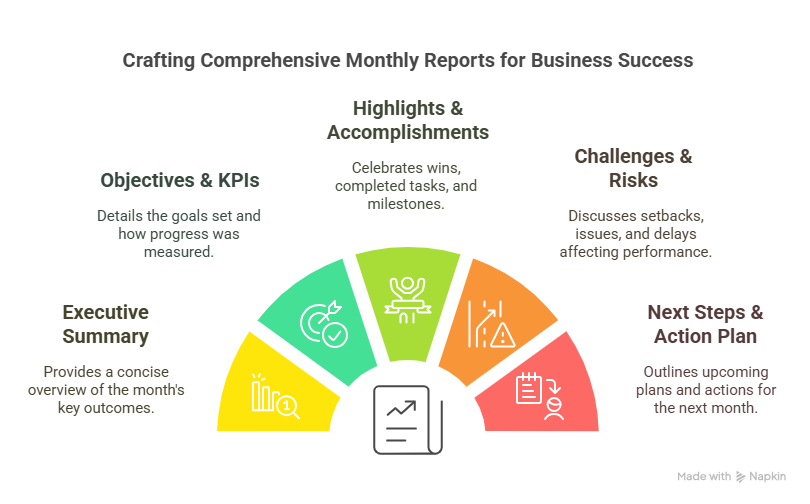Writing a monthly report might sound like a chore—but it doesn’t have to be. Whether you’re leading a team, managing projects, or running a business, knowing how to write a monthly report that’s clear, concise, and actionable can make a massive difference. A well-crafted report gives your stakeholders a snapshot of what’s working, what needs attention, and where you’re heading next.
In this guide, you’ll learn exactly how to write a monthly report from scratch—without overthinking it. We’ll walk through each step, from choosing the right monthly report format, to writing a compelling executive summary, and even using a proven monthly report template to save you time. You’ll also discover practical report writing tips to keep your content focused and professional.
Whether you’re creating a monthly performance report for your boss or updating your team on KPIs, this article gives you the tools and structure to do it right—every time. Let’s cut the fluff and get to the real stuff: how to write reports that people actually want to read.
What is a monthly report and why it matters?
A monthly report is a recurring document that summarizes progress, results, and goals over a month. It’s essential for keeping stakeholders informed and making data-driven decisions. If done right, it can be a powerful communication tool that shows value and identifies areas for improvement.

A monthly performance report helps you:
- Track and measure progress toward objectives
- Identify challenges or blockers before they escalate
- Improve transparency and team accountability
To learn more about why monthly reporting matters in project management, check out Wrike’s article on reporting benefits.
Key elements to include in a monthly report
Before you start writing, it’s important to know what to include in a monthly report. A clear structure keeps your document focused and useful.
A good monthly report format typically includes:
- Executive summary – A quick overview of the month’s key outcomes
- Objectives & KPIs – What goals were set and how progress was measured
- Highlights & accomplishments – Wins, completed tasks, or milestones
- Challenges & risks – Setbacks, issues, or delays that affected performance
- Next steps or action plan – What’s coming up next month
- Supporting data – Graphs, charts, or attachments to support your insights

If you’re including financial summaries like assets and liabilities in your report, make sure you understand how to read or prepare a proper balance sheet. Learn how to prepare one easily here.
Want a ready-to-use format? Here’s a free monthly report template from ClickUp to help you get started.
How to structure your monthly report for clarity and impact
A solid structure can transform your report from a boring text block into something people actually want to read. In this section, we’ll focus on layout, clarity, and presentation.
Use clear headings and subheadings
Break your content into logical sections. Use H2s and bullet points so readers can scan the report quickly.
Bullet points help:
- Summarize complex data
- Highlight key takeaways
- Improve readability
Write concise and objective summaries
Stick to the facts. Avoid opinions unless you’re explaining a situation or decision-making process. Keep sentences short and action-oriented.
Visualize data when possible
People process visuals faster than text. Include graphs, charts, and tables wherever you can.
Here’s a guide by HubSpot on creating data that actually tells a story.
Monthly report template you can use right away
Instead of starting from scratch, use a structure that’s already been tested. Below is a practical monthly report template you can apply to any business or project.
Summary table:
| Section | Purpose | Example |
|---|---|---|
| Summary | Main achievements of the month | “Completed new onboarding process” |
| KPIs | Measurable results | “Website traffic: +12%, Revenue: $30K” |
| Challenges | Problems or blockers | “Delays due to staff shortages” |
| Next steps | Planned tasks for next month | “Hire 1 new developer” |
| Notes | Additional insights or comments | “Client feedback was overwhelmingly positive” |
External resource: For a wide range of report layouts, check out Canva’s monthly report templates.
Tips for writing an effective monthly business report
Even with the best format, your writing matters. Use these proven report writing tips to make sure your message lands clearly.
Tips to improve your report:
- Know your audience: tailor the tone and detail level
- Be concise: keep it to the point and avoid filler
- Use data to back up claims: include only what matters
- Be consistent: use the same format every month
Second list – avoid common mistakes:
- Don’t overload the report with numbers—focus on insights
- Don’t forget the why behind the data
- Don’t make it a copy-paste exercise—context matters
IMAGE: Insert a “before and after” snippet of a poorly written vs. well-written section.
To level up your business writing, here’s a helpful resource from Indeed on writing clear reports.

Bonus for how to write a monthly report
Looking to go further? Here are some bonus tips to make your monthly reports even more powerful and efficient.
You can use tools like Notion, Google Docs, or even AI assistants to automate part of the reporting process. These tools help you collaborate with your team, maintain version control, and standardize your format. Using accounting software can also streamline monthly reporting and data collection.
Extra suggestions:
- Build a report dashboard to feed in live metrics
- Save a template in your report tool of choice to avoid repeating setup
- Use commenting features for better team feedback
IMAGE: Add a visual of a collaborative Notion document in “comment mode” for reports.
Final words
Writing a monthly report doesn’t have to be time-consuming or overwhelming. With a clear structure, the right sections, and a consistent format, you can deliver updates that inform, impress, and drive action. From outlining your monthly performance to highlighting wins and planning what’s next, every part of your report serves a purpose.
Remember, the goal isn’t to just tick a box—it’s to tell the story of your progress in a way that others can understand and act on. So next time you sit down to write, use the template and tips we’ve covered here. Keep it simple, honest, and useful.
And if you’re not sure where to begin? Start by drafting a short executive summary—then build from there.
FAQ about how to write a monthly report
This section answers common questions people have when trying to create useful monthly reports. Keep these in mind when writing your own.
What should a monthly report include?
At minimum: an executive summary, key results (KPIs), highlights, challenges, and action items.
How long should a monthly report be?
Ideally 1 to 3 pages, depending on audience and project complexity. Focus on clarity, not length.
Can I automate my monthly reports?
Yes. Use Google Sheets, Notion, or dashboard tools like Databox or Monday.com for recurring metrics.
Should I include visuals in a monthly report?
Absolutely. Visuals increase understanding and make the report easier to scan and digest.
What’s the difference between a weekly and monthly report?
A weekly report focuses on short-term tasks, while a monthly report summarizes trends and overall progress.
